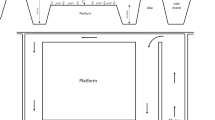Abstract
Marsupenaeus japonicus Bate is one of the most valuable cultured shrimp species in China and outdoor earthen pond farming is the most common method of culturing this organism. The need to increase soil usage efficiency in aquaculture has been recognized and a great deal of research effort has been directed toward development of super-intensive farming systems. However, current research and development in this field is largely devoted to Litopenaeus vannamei Boone, while to M. japonicus Bate it has been neglected. In this study, a layered farming system was designed and a 66-day study was conducted in M. japonicus Bate culture. The system comprised bracket and sand layers that divided a shrimp tank filled to a depth of 1.2 m into four water layers. Conventional tank culture (unlayered) was used as a control. The results show that survival rate, feed conversion efficiency and production of M. japonicus Bate in the layered farming system were 68%, 18%, and 0.59 kg/m2, respectively, all of which are significantly higher than in the unlayered farming system (P <0.01). These findings confirmed the possibility of using a layered system to culture M. japonicus Bate.
Similar content being viewed by others
References
Coman G J, Crocos P J, Preston N P, Fielder D. 2004. The effects of density on the growth and survival of different families of juvenile Penaeus japonicus Bate. Aquaculture, 229: 215–223.
Jackson C J, Wang Y G. 1998. Modelling growth rate of Penaeus monodon Favricius in intensively managed ponds: effects of temperature, pond age and stocking density. Aquac. Res., 29: 27–36.
Li Y Q, Li J, Wang Q Y. 2006. The effects of dissolved oxygen concentration and stocking density on growth and nonspecific immunity factors in Chinese shrimp, Fenneropenaeus chinensis. Aquaculture, 256: 608–616.
Li Y Q, Li J, Wang Q Y. 2010. Effects of size grading on growth and non-specific immunity factors of the shrimp Litopenaeus vannamei Boone. Agric. Sci. China, 9(3): 416–422.
Lin Q W, Shan B D, Liu L D, Huang J Q. 2001. Studies on high density culture of Penaeus japonicus in shrimp hatchery in autumn in north China. J. Oceanogr. Taiwan Strait, 20(4): 510–514. (in Chinese)
Liu Y S, Zang W L, Dai X L, Hou W J, Zhang Y, Yang M, Ding F J. 2011. Growth of Litopenaeus vannamei and budgets of nitrogen and phosphorus in indoor culture systems with different water levels. J. Hunan Agric. Univ. (Nat. Sci.), 37(5): 526–530. (in Chinese)
Liu Y, Yang H S, Liu S L, You K, Zhang F S. 2005. Experimental study on the appropriate breeding density for the production of prawn in closed-recirculating system. Trans. CSAE, 21(6): 122–125. (in Chinese)
Rodrigo P B, Niwooti W. 2007. Effect of culture season and stocking density on growth and production of giant freshwater prawn (Macrobrachium rosenbergii de Ma) raised in northern Thailand. Maejo Int. J. Sci. Technol., 1(2): 216–221.
Sun K, Ye X M, Lin J M. 2004. Experiment on culture of Penaeus (Marsupenaeus) japonicus by using winter unutilized pond in the north of Zhejiang. Mar. Fish., 26(1): 66–67. (in Chinese)
Tang Y Y. 2005. Non-pollution culture techniques of Penaeus monodon. Fish. Mod., (2): 10–11. (in Chinese)
Turkmen G. 2005. The first test shrimp culture results from Izmir-Turkey. Conference on International Agricultural Research for Development. October, Stuttgart-Hohenheim.
Wang K X. 2008. Principle and Technology of Shrimp Healthy Culture. Science Press, Beijing. (in Chinese)
Wu J L, Namikoshi A, Nishizawa T, Mushiake K, Teruya K, Muroga K. 2001. Effects of shrimp density on transmission of penaeid acute viremia in Penaeus japonicus by cannibalism and the waterborne route. Dis. Aquat. Org. 47: 129–135.
Xu J P, Tan X L, Qian H R. 2012. High-yield culture technology of Penaeus vannamei in high density zero water exchange. Fish. Sci. Technol. Inf., 39(1): 26–29. (in Chinese)
Zhang L P, Hu C Q, Shen Q, Ren C H. 2011. Water quality and survival rate for intensive culture of white leg shrimp, Litopenaeus vannamei, under different cultural density in tropic area of China. J. Trop. Oceanogr., 30(4): 85–91. (in Chinese)
Author information
Authors and Affiliations
Corresponding author
Additional information
Supported by the Science and Technology Plan of Qingdao (No. 10-3-4-5-6-jch), the National Natural Science Foundation of China (No. 31101916), the Natural Science Foundation of Shandong Province, China (No. ZR2010CM060), and the University Student Innovation Plan of Qingdao Agricultural University (No. 201030)
Rights and permissions
About this article
Cite this article
Li, Y., Jiang, L. & Wang, R. Layered farming for Marsupenaeus japonicus Bate. Chin. J. Ocean. Limnol. 32, 549–553 (2014). https://doi.org/10.1007/s00343-014-3112-8
Received:
Accepted:
Published:
Issue Date:
DOI: https://doi.org/10.1007/s00343-014-3112-8




